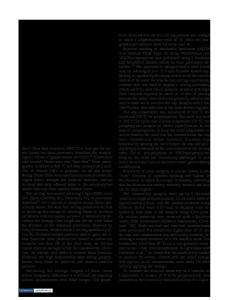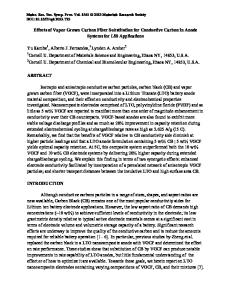Control of the Length and Density of Carbon Nanotubes Grown on Carbon Fiber for Composites Reinforcement
- PDF / 5,418,178 Bytes
- 6 Pages / 612 x 792 pts (letter) Page_size
- 76 Downloads / 365 Views
Control of the Length and Density of Carbon Nanotubes Grown on Carbon Fiber for Composites Reinforcement Lays D. R. Cardoso1, Vladimir J. Trava-Airoldi1, Fabio S. Silva2, Hudson G. Zanin1, Erica F. Antunes1and Evaldo J. Corat1 1
National Institute for Space Research – INPE, LAS, Avenida dos Astronautas 1758, 12227-010 São José dos Campos, S.P., Brazil 2 Brazilian Aerospace Company SA – Embraer, Avenida Brigadeiro. Faria Lima 2170, 12227-000 São José dos Campos, S.P., Brazil ABSTRACT Aligned multi-walled carbon nanotubes were grown on carbon fiber surface in order to provide a way to tailor the thermal, electrical and mechanical properties of the fiber-resin interface of a polymer composite. As the deposition temperature of the nanotubes is very high, an elevated exposure time can lead to degradation of the carbon fiber. To overcome this obstacle we have developed a deposition technique where the fiber is exposed to an atmosphere of growth for just one minute, and different concentrations of precursor solution were used. INTRODUCTION The low weight, high mechanical properties and chemical resistance of advanced composite make them ideal materials for structural applications [1-5]. The aerospace industry has used them in aircraft parts with the aim to reduce the weight, to improve the performance and therefore to minimize the fuel consumption and the pollutant emission [2]. The needs of aerospace, automobile and electronic industry to develop high performance structural composites have mobilized the scientific community to improve the utilization of carbon nanotubes (CNTs) on advanced structural composites. The use of CNTs on carbon fiber (CF) reinforced polymeric composites has been widely explored in recent years [3-6]. However, the predicted reinforcement that CNTs could provide to the composite [7-8] has not been achieved yet. Dispersion, alignment and adhesion of CNTs in polymer matrices are essential to the structural reinforcement [4-5,9], but dispersing CNTs on the matrix is not an efficient process, due to issues such as agglomeration and poor dispersion into the bulk matrix [10-11]. The growth of CNTs radiallyaligned directly on fiber, creating a “fuzzy fiber”, has been a better alternative for improving fracture toughness, interlaminar and intralaminar strength, and wear resistance of advanced fiber composites [12]. But Qian et al. showed that the CNT deposition process results in a 55% reduction in fiber tensile strength (from 3.5 to 1.6 GPa) [13] due to the high growth temperature of CNTs (730 °C - 850 °C). Work by Sager et al., employing floating catalyst CVD (Chemical Vapour Deposition) process, also showed similar degradation levels in tensile strength as well as tensile modulus of high-performance carbon fibers following CNT growth [14]. To overcome this problem we developed a CVD deposition technique where the carbon fiber is exposed to high temperature (800 °C), in an atmosphere of CNTs growth, for just one minute in order to preserve the mechanical properties of the CF.
EXPERIMENT The cloth of c
Data Loading...











